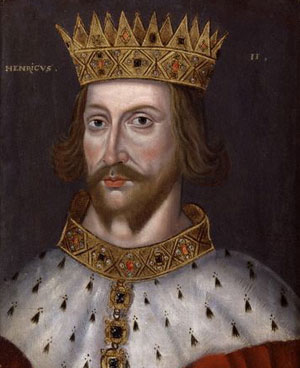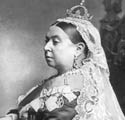Henry II (5 March 1133 – 6 July 1189). King of England (1154–1189) Henry II achieved some significant accomplishments in his time asking. He helped end the infighting which had plagued the country during the reign of Stephen and re-established the central control that his grandfather Henry I had established. He also laid a framework for common law and the right for citizens to be tried in courts – the forerunner of our modern criminal justice system. He is often best remembered for his dispute with Thomas a Becket – a former friend, who on becoming Archbishop of Canterbury refused many of Henry’s wishes to strengthen the power of the state over the church. After expressing his frustration, knights loyal to Henry II murdered Thomas a Becket in Canterbury Cathedral. It was an event that shocked Europe and was a definining part of his reign.

During his early life, England was riven with conflict. There had been a bitter civil war (known as the ‘anarchy’) between Stephen the nephew of King Henry I and Matilda, the daughter of Henry I.
After Henry II’s marriage, he travelled to England where he persuaded King Stephen to make him heir to the throne on account of his Grandfather Henry I and his new marriage to Eleanor. King Stephen agreed to this and King Henry II was crowned two years later in 1154.
Achievements of Henry II
Henry II went on to become a powerful regent, strengthening the power and prestige of the Crown. When he came to power, England was in ruins, with little control and local barons very powerful. Henry II was skilful in regaining administrative control and bringing together some of the best minds in managing the exchequer. Henry took a personal interest in the management of his country and the methods of governance were celebrated in a document Dialogus de scaccario.
A key figure in quelling the power of rebellious barons was Thomas a Becket. As soon as Henry met Becket, he felt a strong personal chemistry and admired his skills of diplomacy, charm and intelligence. Becket successfully improved the king’s finances and brought the barons to heel, which left Henry II grateful to his minister.
National justice system
One of Henry’s greatest achievements was the introduction of a national justice system. Before coming to power, issues of crime and punishment were haphazard and left to local sheriffs. A person’s guilt could even be settled during a trial by ordeal. Through the Assize of Clarendon (1166), Henry II instituted a system of prisons and courts, paid for by the king. It was Henry II who set up a primitive form of trial by jury, with 12 men acting as a judgement on the person on trial. Also, these courts would be overseen by the king’s own justices. The aim was to provide a degree of uniformity in justice and sentencing. It also helped speed up justice and avoid ‘blood feuds’ where individuals and families felt they should pursue their own justice. Henry’s reforms and administration form the basis of Britain’s modern justice system and encouraged the development of judges and experts in finance and law. The new system of justice was partly paid for by the introduction of scutage – a situation where men could pay to avoid military service.
Dispute with Thomas A Becket
After Becket proved a loyal and able minister, Henry and sought to promote him to the second most important (after the king) position in the country – Archbishop of Canterbury. In 1161, Becket wasn’t even a priest and had a reputation for enjoying the pleasures of the court. Henry had Becket made a priest and the next day Archbishop of Canterbury. However, on becoming archbishop, Becket seemed to be inspired by the post and became much more religious and devout. As a result, Becket was no longer willing to be the servant of the king. Becket felt his duty was to serve the church. This led to frequent conflict.
Henry wished for his courts to have supremacy over church courts. Henry felt it was wrong for churchmen to be tried in church courts, which were invariably sympathetic. However, Becket refused to comply and asserted the right of the church took precedence. Henry veered between anger and a wish to be reconciled with his former friend. In 1164, he summoned Becket to confront him but fearing the king’s wrath Becket fled to France where he was given protection. After six years, the pope helped to negotiate a reconciliation and Becket returned to England. But, on his return, Becket took his revenge on priests who had sided with King Henry. When Henry heard of this, he became furious and famously declared ‘will no-one rid me of this turbulent priest?’. On hearing the king’s outburst, four knights took it upon themselves to confront Becket.
Arriving at Canterbury Cathedral, they asked Becket if he would pardon those who he had punished for loyalty to the king. Becket was dismissive and the knights killed him in cold blood within the holiest place in England – Canterbury Cathedral. The murder caused shockwaves throughout the country and Europe. When it was discovered Becket was wearing a hairshirt – proof of his sanctity – he was quickly elevated to the status of a saint and it made Henry look guilty by his association with the deed.
To assuage public opinion and probably out of deep personal regret, Henry II humbled himself to do public penance at his shrine.
Towards the end of his reign, Henry II travelled to Ireland to defeat a potential Norman Challenger to the throne. This established an English presence in Ireland.
A bigger challenge came from his own sons. He wished to divide his territories amongst the. However, there was deep distrust amongst his sons and his eldest son, Henry sought to oppose his father’s wish to give territory to his brother John. Henry’s son fomented a revolt by barons and those displeased with King Henry. However, Henry II returned and quelled the rebellion. Yet, the simmering resentment continued to flare up and he quarelled with his sons until his death near Tours in 1189.
Was Henry II unfairly blamed for Thomas a Becket’s death?
History loves saints and sinners. Since Becket was canonised, a cursory view may be to paint Henry II as a bad king. However.
Henry II made excellent reforms to law and order. His request to oversee church law was not unreasonable, there was good reason to suspect the church were not being fair in their execution of the law.
Whilst it is likely Henry II did say (in a drunken rage) ‘Will no-one rid me of this turbulent priest?’ – it shouldn’t be taken as a direct order. It is quite likely Henry II was genuinely shocked when his old friend was murdered.
Although his public penance was partly to regain people’s trust, there is evidence he was sincere in his efforts to seek forgiveness.
Henry II ruled between the Norman Conquest (1066) and Magna Carta (1215) But his legal reforms and establishment of justice is a very significant step forward in English common law. It was pioneering in global terms for a king to seek a fairer way to implement justice and marks an important turning point from haphazard feudal systems to modern standards.
Citation: Pettinger, Tejvan. “Biography of King Henry II”, Oxford, www.biographyonline.net. Published 11 March 2020.
Related pages


